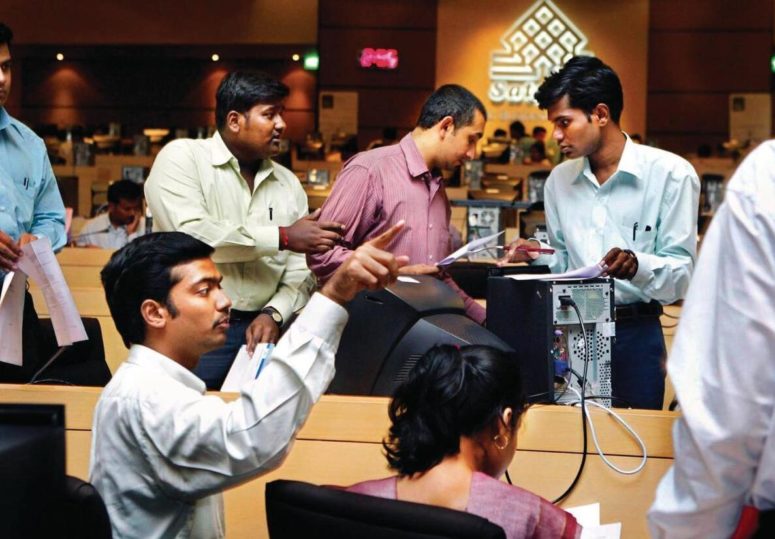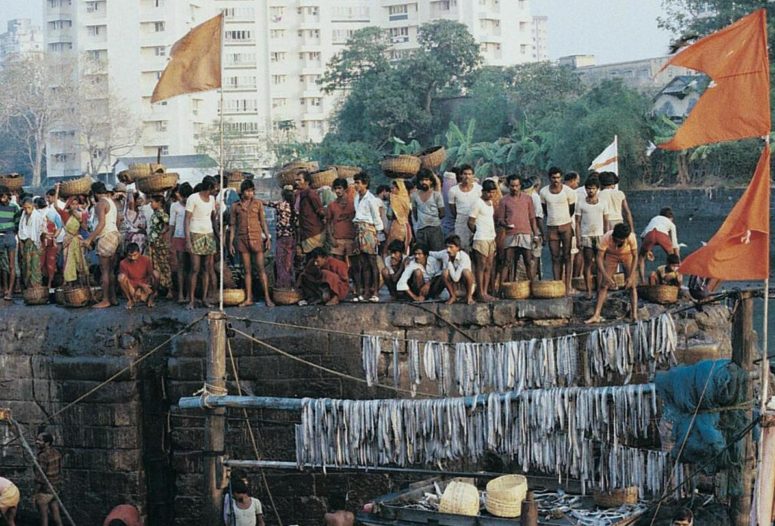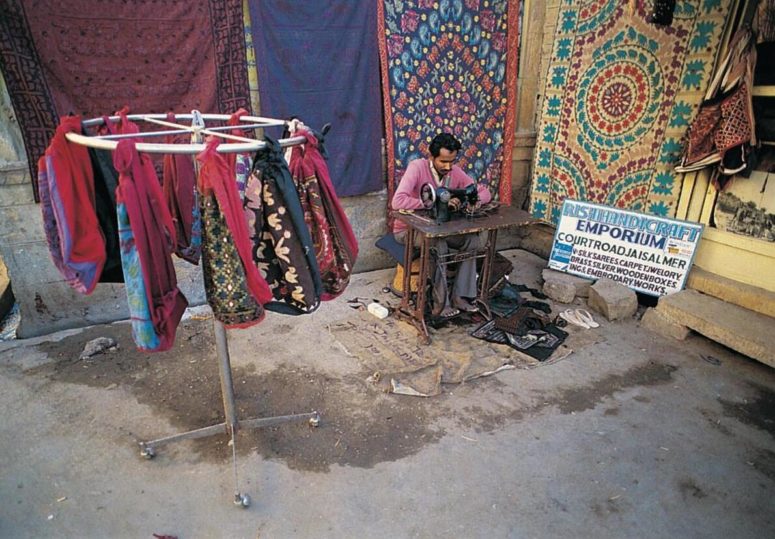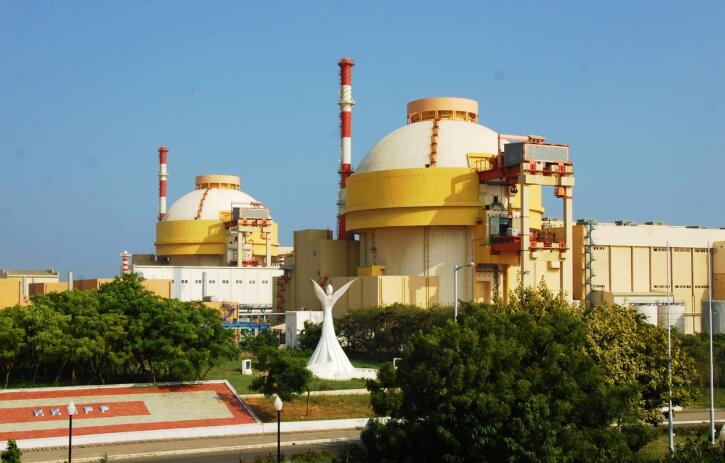India is one of the world’s largest economic powers, while also among the world’s poorest, in terms of gross domestic product (GDP) per capita.
The country has experienced strong economic growth since the late 1990s. The reasons are strong growth in the manufacturing industry, huge upswing in the IT sector, relatively liberal economic policy and a strong increase in foreign investment.
India has developed an open market economy. In the 1990s, a liberalization of the economy began, involving industrial deregulation, privatization of state-owned enterprises, increased exports of Indian goods, reduced control of foreign trade and foreign investment. This has contributed to strong economic growth.
Government enterprises have been privatized, and the state has less control than before in private companies’ production and investment policies. The reform work has been supported by the International Monetary Fund and the World Bank.
India has a diverse economy consisting of traditional agricultural production, modern agriculture, crafts and a wide range of modern industrial activities. About half of the population worked in agriculture, but service industries accounted for most of the economic growth.
India has from the 1990s developed a strong IT industry with competent professionals. The country has a large export of software services and of staff with software expertise.
The country’s economic growth has slowed somewhat since 2011. This is due to both a decline in public consumption and a decline in investment due to investors’ pessimism regarding the government’s ambitions to further economic reforms and also pessimism for global development in general.
In 2012, the Indian government announced that it will implement several reforms to avoid a further slowdown in economic growth. The reforms mean that the authorities allow stronger foreign participation in the investments.
For parts of the Indian middle class, the reforms have provided an economic boost, but for India’s poor, they have faced difficulties by reducing subsidies and support schemes.
It is estimated that around 270 million of the country’s approximately 1.2 billion inhabitants live below the poverty line (2013). India has a large, relatively affluent middle class (about 300 million inhabitants), by far the largest in the Third World.
Two-thirds of India’s exports go to the EU, the US and Japan.
Tea plantation in the south Indian state of Kerala. India is the world’s largest producer of tea, grown especially on the slopes.
Agriculture
Agriculture is the dominant industry, accounting for 47 per cent of employment and 15.4 per cent of gross domestic product (2016). India has considerable agricultural land and over half of the land is cultivated. However, the soil is generally less fertile, and soil erosion is common in many parts of the country. Agriculture is run partly as self-storage farms on small farms and partly as commercial agriculture on large plantations.
The uses are consistently small. Simultaneously possess great gentry large space leased out, and many farmers are tenants or landless farm workers. Land reform has only partially succeeded in abolishing the traditional leasing system.
The crops per unit area are usually small. It is common for livestock manure to be used for fuel, and the consumption of manure has been minimal. Furthermore, recurring floods and droughts cause India to undergo major crop failure for some years. Artificial irrigation is done by means of channels from the rivers, wells and rainwater collection ponds. The irrigation plants make it possible to obtain a crop in the dry season in the spring ( rabi ), in addition to the crop in the humid season in the autumn (kharif).
The use of irrigation and the introduction of new cereals have yielded increased crops of rice and wheat, but the country is still not completely self-sufficient with food grains and other foods. In theory, three-quarters of agricultural land can be artificially watered. The introduction of new and better cereals (“miracle rice”) has in particular come to be of greater use with efficient irrigation plants, and has thus intensified the inequalities in the agricultural sector (see green revolution ).
Fishing pier in Mumbai early in the morning.
Food grains occupy about three quarters of India’s cultivated area. Rice is the most important grain type, covering about 25 percent of the grain area. The rice is extensively cultivated in the delta areas along the east coast, in the states of Andhra Pradesh, Tamil Nadu and West Bengal. In Central and Northern India in Bihar, Madhya Pradesh and Uttar Pradesh in Central and Northern India.
Wheat is the other major food crop and is grown in the drier parts of northern India, especially in Punjab, Madhya Pradesh and Uttar Pradesh, which together have two-thirds of India’s wheat area. Corn thrives both on the plains and in the mountains and is the main crop in some mountain tribes. Normally, corn is grown next to millet or rice; most prevalent is maize cultivation in the lower part of Gangessletta. The Belgian fruits are of great importance both for the nutrient cycle in the soil and as a source of protein in the diet.
A tailor at work, in Jaisalmer, Rajasthan. A significant part of India’s business is conducted in small businesses, often at family or village level.
The most important plant growth is tea, which before the country’s independence was the most important export commodity. India is the world’s largest tea producer with about 30 percent of world production. Tea is mainly grown on the hillsides of Assam and in the Kunda Hills in southern Deccan (Karnataka, Kerala, Tamil Nadu).
Almost the entire world production of jute is grown in Bengal, and India is the world’s largest producer country, along with Bangladesh. India is also the world’s largest sugar producer. Sugarcane is grown in almost every part of the country, but is most common in the upper part of Gangessletta. Uttar Pradesh alone accounts for half of the country’s production.
Cotton is mainly grown in the northwestern Deccan and in the Kathiawar Peninsula and India is the world’s third largest producer. As a tobacco producer, India is the world’s fourth largest. Also groundnuts ( peanuts ) are of great importance. The peanuts are used to make oil; only a minor portion is exported. Coffee in southern India is also grown and rubber yeast is extracted, on the southwest coast, among other things, coconut palms and cardamom grow. India is also the world’s largest producer of rapeseed, sesame seeds, flax seeds, hemp and pepper.
The animal husbandry is large, but yields little return, due to lack of feed and poor breeding. India has more cattle than any other country, but its economic value is limited, primarily due to religious reservations against the exploitation of cattle, but also due to low intensive operations. Milk yield per animal is perhaps the lowest in the world, but the large number of milk producing animals contributes to India being the world’s largest milk producer.
Forestry
The large forest areas that once existed in India are now greatly reduced. The forest (2008) barely covers one fifth of the country’s land, and much of this forest is degraded to scrub. Furthermore, the forest is very unevenly distributed across the different regions, and is almost completely absent where the need for timber and other forestry products is greatest – as in the densely populated and intensively cultivated Gangessletta. The largest forest areas are found on the slopes of the Himalayas and in the states of Madhya Pradesh, Assam, Orissa and Andhra Pradesh. Teak, saddle, bamboo and various conifers have the greatest economic significance. The utilization of forests has been intensified since independence, and the harvesting is in many places far greater than regrowth. The forestry industry does not play a significant role in the country’s economy.
Fishing
India has a vast continental shelf of around 300,000 square kilometers and is among the world’s largest fishing nations, although fishing contributes to the country’s economy to a relatively small extent. The fishing industry is most important in Kerala, Tamil Nadu and Maharashtra, which together account for just over half of the catch. Deep sea fishing and freshwater fishing have shown considerable growth, and the fishing industry has theoretically great expansion opportunities.
Mining
India has relatively rich deposits of energy minerals and ferrous metals, but is not self-sufficient with non-ferrous metals. Mineral deposits are largely concentrated in the border area between Bihar, Orissa, West Bengal and Madhya Pradesh. Together, these four states account for over three-quarters of mineral production (measured by value).
India has the world’s fourth largest coal reserves, estimated at over 30 billion tonnes. The most important deposits are found in the Damodard Valley in Bihar and West Bengal. Coal is also found in Assam, anthracite in Kashmir and lignite in Tamil Nadu.
Petroleum is extracted in Assam, Gujarat and Nagaland, and offshore, including off the coast of Maharashtra and in the Bay of Bengal. The Bassei gas field (one of the world’s largest) was put into production in 1985.
The deposits of iron ore are among the largest in the world. The largest deposits are in Bihar and Orissa, smaller deposits are found in Madhya Pradesh, Karnataka, Goa, Andhra Pradesh and Tamil Nadu. Chromium is found in Karnataka, Bihar and Orissa, but mining has been waning. Magnesite occurs in southern India. Furthermore, there are relatively large occurrences of bauxite ; most come from Ranchi in Bihar and from Gujarat and Madhya Pradesh.
There are also rare and valuable minerals in a certain amount. As much as 70 percent of the world’s mica production is mined in Bihar in the east and in Rajasthan and Punjab in the west. In Rajasthan, large quantities of plaster are also extracted. The coast of Kerala has the world’s largest deposits of ilmenite and large amounts of zirconium. Uranium is extracted in Bihar and Rajasthan, and the deposits of thorium in northeastern India are among the largest in the world. Otherwise, smaller amounts of apatite, asbestos, barite, lead, diamonds, dolomite, gold, refractory clay,limestone, copper, corundum, sillimanite, zinc, steatite and silver. Salt is produced from seawater in the Gulf of Kutch and along the coast of the Deccan.
Energy
In 2016, India’s consumption of primary energy sources was estimated at 36.1 EJ ( ex joules ). It represents 6.3 per cent of the world’s total energy consumption, placing India as the third largest energy consumer in the world. Per capita consumption was 27.2 GJ compared to 77.5 GJ in the rest of the world. Self-generated energy is estimated at 23.3 EJ, which gives a self-sufficiency of 65 per cent.
India’s most important commercial energy sources are oil and coal. The country is the world’s second largest producer of coal (after China ), which in 2017 was 730 million tonnes. In addition, the country had to import 207 million tonnes. Oil imports were 214 million tonnes.
The consumption of electrical energy has increased rapidly in recent years. Extensive expansion of the power grid has led to the electrification of most communities. In 2016, final consumption per capita was 840 kWh. The country is mainly self-sufficient with self-generated electrical energy, which in 2016 was 1478 TWh. Power generation was mostly based on fossil energy sources, with coal power alone accounting for 75 per cent (1105 TWh).
Renewable energy was used for 15 per cent of the country’s power generation. Of this, hydropower contributed 138 TWh (9 per cent). The country has large hydropower reserves in both the Himalayas, the Western Ghats and the mountains to the south, but seasonal variations in water flow are a problem. The other renewable energy sources used for power generation are solar and wind energy with a total of 59 TWh (4 per cent) and biomass with 44 TWh (2.9 per cent). Biomass in the form of agricultural residues has an important function as fuel in India, especially in the countryside and for the urban poor.
Nuclear power contributed 38 TWh (2.6 per cent). The country has ambitions to increase its share of nuclear power, but faces difficulties as a result of not signing the Non-Proliferation Agreement.
Industry
The industry employs about 13 percent of the country’s workforce and accounts for about 29 percent of the gross domestic product.
Up until the economic reform process in the 1990s, the industrial sector was characterized by strong government control and stagnation. Economic reforms have given the industrial sector significantly better conditions and contributed to modernizing the sector.
The structural changes in the industry were significant from the 1990s. The large state conglomerates were reduced. Instead, smaller companies emerged that largely focused on high technology. The Indian computer industry, with its Bangalore center, “India’s Silicon Valley “, showed strong growth, especially in software exports. A number of international car manufacturers began co-production with Indian partners. In recent years, there has also been significant growth in the high-tech-based industry, which is aimed, among other things, at the country’s aerospace business.
At the time of the liberation, the country had the advantage over many other former colonial states that there was an industrial tradition. This tradition was built on old, industrially embossed crafts, with the production of fine textiles in the 17th and 18th centuries. The first cotton factory was established in Mumbai (Bombay) in 1851, and the first jute factory in Kolkata (Calcutta) in 1855. However, India’s industrial development was severely hampered in the 19th century, when the country was primarily developed as a supplier of raw materials for and market for British industrial goods.
Just like India’s cotton industry, the country’s iron and steel industry is created by the Indians themselves. The first ironworks in Jamshedpur (225 kilometers west of Kolkata) was opened in 1911 at the initiative of the parser Jamshedji Tata, “the father of the Indian industry”. The Jamshedpur plant was later developed with steel mills and a wide range of related industries. Tata Iron and Steel Works built another ironworks in the 1930s in Belur, north of Kolkata.
During the First World War, the Indian industry had its first major period of prosperity, when the country had to replace important import goods, primarily textiles and railway materials. Also World War meant a powerful industrial expansion.
After independence, industrialization went fast. There has also been a spread from traditional industrial centers such as Mumbai, Calcutta and Chennai to the other parts of the country. The Damodard Valley northwest of Kolkata has developed into “India’s Ruhr “, with 90 per cent of the country’s coal mining and including steel mills, aluminum plants, machine factories and the chemical industry. The expansion of India’s industry has especially taken place in the “modern” industrial sector, both in the heavy industry and the lighter industry.
The industry is largely concentrated in the states of Maharashtra (with the metropolis of Mumbai), West Bengal (with Kolkata) and Tamil Nadu (with Chennai). Bangalore in Karnataka is an important center of high-tech industry.
The cotton industry is still India’s most important industry. India is, after China, the world’s largest producer of cotton. Mumbai is the main center of the cotton industry; other important centers are Ahmadabad (“India’s Manchester”), Nagpur, Kanpur, Sholapur as well as several places in Tamil Nadu, including Coimbatore and Chennai. The other traditional textile industry, the jute industry, is concentrated to Kolkata and the rest of West Bengal.
The silk industry has long traditions in West Bengal, Punjab and South India, but today plays a modest role. The fiberglass industry is of recent date, with centers in Benares, Hyderabad and Ahmadabad, among others.
A significant part of the country’s commodity production takes place in smaller and more informal units, often at family or village level; including traditional craftsmanship, as well as a wide range of goods.
Foreign Trade
From the 1980s, political efforts were made to promote exports. India has since the 1990s made the regulations more suitable for export and import of goods. In 1991, India and China resumed trade relations, having ceased in 1962.
While India’s exports were previously dominated by tea, jute and cotton, today’s exports are more diverse. India is a major exporter of oil products. Cut diamonds (which are imported rough), and other gemstones are important export products. In addition, cotton textiles and clothing products, machinery and transport equipment, leather and leather products, chemicals and fish and shellfish are exported.
India also has large exports of software services and software expertise.
Today, imports are dominated by oil and oil products, machinery and transport equipment.
The United States, China, Japan, the United Arab Emirates and the United Kingdom are India’s most important trading partners.
Foreign Trade
Foreign trade as a percentage by country 2017
| Countries | Export | Import |
| United States | 15.6 | 5.5 |
| United Arab Emirates | 10.2 | 5.2 |
| Hong Kong | 4.9 | – |
| China | 4.3 | 16.3 |
Exports as a percentage of major commodity groups 2007
| Fuel oils etc. | 14.9 |
| Diamonds (towed) and ornaments | 12.7 |
| chemicals | 4.5 |
| Iron and steel | 4.4 |
| Cotton | 3.1 |
Imports as a percentage by main product groups 2007
| Fuel Substances | 33.3 |
| Diamonds (rough) and ornaments | 12.2 |
| Electric machines, appliances | 7.8 |
| Iron and steel | 3.3 |
| chemicals | 3.2 |
| Aircraft, parts and aerospace equipment | 2.8 |
Transport and Communications
Railways
Under the British colonial rule, an extensive railway network was built, and the country had over 48,000 kilometers of railways on its independence. The railways are state-owned, and India’s first two five-year plans put great emphasis on improving the railways by expanding the lines, adding double tracks and accelerating electrification. The Indian railway system is the largest in Asia and among the largest in the world. The rail network has a total length of about 68,500 kilometers (2014).
The road network
The road network is still poorly developed, and has been given lower priority than, for example, the railways. The road network has a total length of 4.7 million kilometers (2015), of which about half has a fixed tire.
Avian
The state airline Air India had a long monopoly on air traffic, but since the 1980s a number of private airlines have been established operating both domestic and international flights. International airports can be found in Mumbai (Bombay), Calcutta, Delhi, Chennai (Madras) and Trivandrum. In total, there are 346 approved airports in India.
Shipping
Coastal traffic and foreign trade have increased steadily since independence. The busiest ports are Mumbai, the oil port of Kandla, Chennai, Mormugao with the shipment of iron ore from Goa, Vishakhapatnam, Kolkata with the port of Haldia and Cochin.



